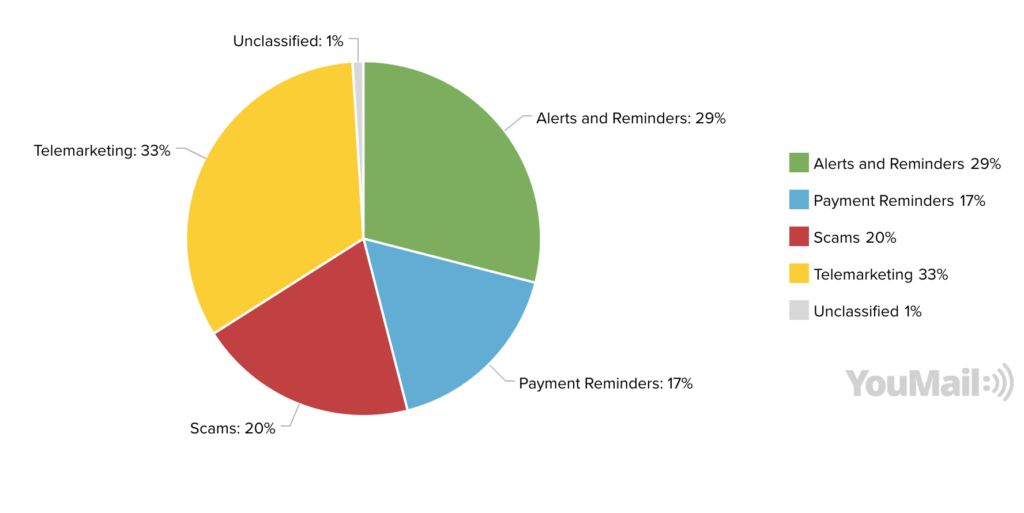As robocalls and robotexts continue to inundate consumers, their effects in 2024 are as disruptive as ever. These calls not only cause daily frustration but also pose significant risks, with scammers becoming more sophisticated in their approach. In this article, we explore the different types of robocalls, the rising threat of scam calls, and how telemarketing continues to dominate the robocall landscape.
In this article we will cover:
- The Current State of Robocalls in 2024
- Telemarketing: The Leading Cause of Robocalls
- The Growing Threat of Scam Calls
- The Rise of Scam Texts and Robo Texts
- Alerts and Payment Reminders: When Robocalls Are Useful
- Protecting Yourself from Robocalls and Scam Texts
The Current State of Robocalls in 2024
In September 2024, an estimated 4.5 billion robocalls were made in the U.S., meaning millions of Americans were subjected to unwanted communications. What’s troubling is that many of these calls are not just annoying—they can be downright dangerous. Scam calls and scam texts target vulnerable populations, attempting to deceive them into giving away personal information or money.
Telemarketing campaigns remain the most common type of robocall, but the rise in scam calls and robotexts is changing the landscape. Let’s break down the current state of robocalls:

- Telemarketing: 33%
- Scam Calls: 20%
- Alerts and Reminders: 29%
- Payment Reminders: 17%
- Unclassified: 1%
It’s no surprise that telemarketing is the largest category of robocalls. Businesses continue to use automated calling systems to reach potential customers. But as telemarketing dominates, scam calls are growing, becoming more invasive and difficult to block.
Telemarketing: The Leading Cause of Robocalls
Telemarketing calls remain the primary reason for the overwhelming volume of robocalls. Companies use robocall systems to promote products and services, often dialing thousands of numbers in a single day. These calls range from legal marketing efforts to unsolicited sales pitches that straddle the line between telemarketing and spam.
The legality of telemarketing calls depends on several factors, including whether the recipient has provided consent to be contacted. However, many telemarketing campaigns exploit loopholes, leading to increased complaints from consumers who never agreed to receive these calls. Despite regulations like the Telephone Consumer Protection Act (TCPA), which aims to curb unwanted robocalls, the problem persists.
The Growing Threat of Scam Calls
While telemarketing is frustrating, scam calls pose a far greater threat. These robocalls are designed to deceive, often mimicking legitimate entities such as government agencies, financial institutions, or tech companies. Scammers have become more sophisticated, using tactics like caller ID spoofing to appear legitimate and prey on unsuspecting individuals.
Scam calls make up 20% of all robocalls, but their impact is much larger. The financial losses associated with scam calls are staggering, with fraudsters successfully stealing millions of dollars each year from unsuspecting victims. Common types of scam calls include:
- IRS Impersonation Scams: Scammers pose as IRS agents, threatening legal action unless the victim makes an immediate payment. More on IRS Impersonation Scams
- Banking Scams: Fraudsters claim there has been suspicious activity on the victim’s account, asking them to confirm personal details. More on Bank Imposter Scam Calls
- Tech Support Scams: These scammers pretend to be from well-known tech companies, telling victims their devices are infected and need immediate assistance. More on Tech Impersonation Scams.
Victims of frauduelent scam calls can suffer significant financial losses, and the emotional toll can be just as damaging, especially for older adults who are frequent targets of these scams.
The Rise of Scam Texts and Robo Texts
Not only are scam calls on the rise, but scam texts (also known as robo texts) are becoming more prevalent. Scammers send these unsolicited messages to trick recipients into clicking on malicious links, which can lead to identity theft, malware infections, or unauthorized charges.
Many scam texts masquerade as legitimate organizations, claiming to offer prizes, refunds, or account updates. Political campaigns have also taken advantage of robo texts, bombarding voters with messages during election cycles.
The biggest challenge with scam texts is that they are harder to block than traditional scam calls, as text messages often slip past call-blocking apps. Consumers need to be vigilant and avoid clicking on links from unknown senders.
Alerts and Payment Reminders: When Robocalls Are Useful
Not all robocalls are bad. In fact, alerts and payment reminders make up 46% of all robocalls and are often beneficial to consumers. These robocalls include reminders about upcoming appointments, notifications about package deliveries, or alerts about past-due bills.
However, even legitimate alerts and payment reminders can be abused. Some scammers have found ways to disguise their scam calls as legitimate reminders, making it difficult for consumers to distinguish between real and fraudulent calls.
Protecting Yourself from Robocalls and Scam Texts
As telemarketing, scam calls, and robo texts continue to rise, consumers need to take proactive steps to protect themselves. Here are a few tips to safeguard your personal information:
- Use call-blocking apps: Apps like YouMail can help identify and block spam calls, scam calls, and telemarketing calls.
- Don’t answer unknown numbers: If you don’t recognize the number, let it go to voicemail. Most robocallers won’t leave a message.
- Be cautious with text messages: Avoid clicking on links in texts from unknown senders, and report any suspicious messages to your phone carrier.
Download YouMail and instantly stop spam calls, texts, and voicemail.
Conclusion: Stay Vigilant Against Telemarketing and Scam Calls
The robocall problem shows no signs of slowing down, and while telemarketing continues to lead the charge, the rise of scam calls and robo texts presents new challenges. Protecting yourself requires vigilance, awareness, and the use of technology like call-blocking apps to reduce the number of unwanted calls and texts you receive.
As scammers grow more sophisticated, consumers need to stay informed about the latest tactics and be prepared to take action. Download the YouMail app today to block unwanted calls and protect yourself from scams.





